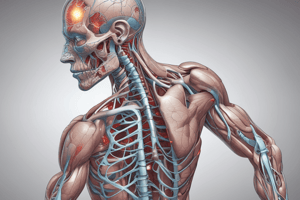Podcast
Questions and Answers
Which movement disorder is characterized by an autosomal dominant inheritance pattern and affects the basal ganglia?
Which movement disorder is characterized by an autosomal dominant inheritance pattern and affects the basal ganglia?
- Parkinson's disease
- Huntington disease (correct)
- Wilson's disease
- Essential tremor
What movement disorder is associated with excessive, involuntary movements affecting different body regions?
What movement disorder is associated with excessive, involuntary movements affecting different body regions?
- Parkinson's disease
- Ballismus (correct)
- Cerebellar ataxia
- Dystonia
Which disorder is known for the presence of motor and vocal tics?
Which disorder is known for the presence of motor and vocal tics?
- Huntington disease
- Essential tremor
- Tardive dyskinesia
- Tourette syndrome (correct)
Which movement disorder is linked to a deficiency in copper metabolism leading to copper accumulation in the brain?
Which movement disorder is linked to a deficiency in copper metabolism leading to copper accumulation in the brain?
Which disorder is characterized by jerky, uncoordinated movements due to cerebellar dysfunction?
Which disorder is characterized by jerky, uncoordinated movements due to cerebellar dysfunction?
What symptom does the 14-year-old boy in the text present to his PCP?
What symptom does the 14-year-old boy in the text present to his PCP?
Which condition is characterized by sudden, brief actions with an urge before and a sense of relief after the movement?
Which condition is characterized by sudden, brief actions with an urge before and a sense of relief after the movement?
What differentiates Tourette's Syndrome from Dystonia based on the text?
What differentiates Tourette's Syndrome from Dystonia based on the text?
What is a common medication used to suppress movements in Tourette's Syndrome according to the text?
What is a common medication used to suppress movements in Tourette's Syndrome according to the text?
Which condition presents as relentless, self-limited movements after a strep infection?
Which condition presents as relentless, self-limited movements after a strep infection?
What is a key consideration for treatment in Tourette's Syndrome based on the text?
What is a key consideration for treatment in Tourette's Syndrome based on the text?
Why would acetylcholine blockers (anticholinergics) be expected to help in Huntington's Disease?
Why would acetylcholine blockers (anticholinergics) be expected to help in Huntington's Disease?
Which neurotransmitter is predominantly affected in Huntington's Disease?
Which neurotransmitter is predominantly affected in Huntington's Disease?
Which area of the brain is primarily affected by the loss of acetylcholine neurons in Huntington's Disease?
Which area of the brain is primarily affected by the loss of acetylcholine neurons in Huntington's Disease?
What is the consequence of reduced excitation upon Gpi neurons in Huntington's Disease?
What is the consequence of reduced excitation upon Gpi neurons in Huntington's Disease?
Why might too much dopamine produce dyskinesias in Parkinson's Disease treatment?
Why might too much dopamine produce dyskinesias in Parkinson's Disease treatment?
What is the main clinical feature observed in Huntington's Disease?
What is the main clinical feature observed in Huntington's Disease?
Which symptom is commonly associated with cerebellar dysfunction?
Which symptom is commonly associated with cerebellar dysfunction?
What type of movement disorder is characterized by writhing and twisting movements?
What type of movement disorder is characterized by writhing and twisting movements?
Which clinical feature is NOT typically seen in Parkinson's disease?
Which clinical feature is NOT typically seen in Parkinson's disease?
What is the aim of the direct pathway in the anatomy of Parkinson's disease?
What is the aim of the direct pathway in the anatomy of Parkinson's disease?
Which part of the body is primarily affected by ataxia?
Which part of the body is primarily affected by ataxia?
What is a common symptom of cerebellar dysfunction related to speech?
What is a common symptom of cerebellar dysfunction related to speech?
What is the significance of frequent throat clearing in the patient described?
What is the significance of frequent throat clearing in the patient described?
What is the most likely diagnosis for the patient based on the symptoms described?
What is the most likely diagnosis for the patient based on the symptoms described?
What treatment approach is suggested for hemiballismus, particularly when caused by damage to Mollaret’s Triangle?
What treatment approach is suggested for hemiballismus, particularly when caused by damage to Mollaret’s Triangle?
How does negative myoclonus differ from other types of myoclonus?
How does negative myoclonus differ from other types of myoclonus?
In the context of tardive dyskinesia, what is the recommended treatment strategy?
In the context of tardive dyskinesia, what is the recommended treatment strategy?
Which brain structure is most likely affected in a patient presenting with hemiballismus?
Which brain structure is most likely affected in a patient presenting with hemiballismus?
Flashcards are hidden until you start studying




